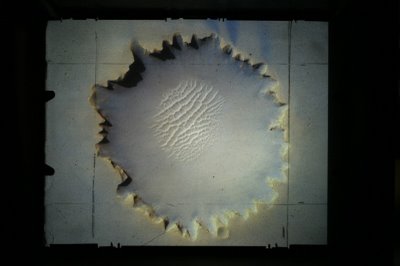Cosmos
 For Christmas, I got the seven-disk box set of the Carl Sagan television science series Cosmos: A Personal Voyage. A few minutes into the first episode, I thought the whole "Spaceship of the Imagination" thing was going to be totally cheesy. But very quickly I became glued to it. Watching five of the 13 hour-long episodes has dovetailed nicely with an another animated stills movie I had been working on throughout December, one that's based entirely on NASA imagery. Since I've already dealt with the moon a lot on this blog, the piece I want to show you focuses mostly on Mars and Saturn. A lot of the images from Mars are from Spirit and Opportunity, the two rovers on the surface of the planet (plus a few images taken by Mars Global Surveyor). And then it's on to Saturn, where the Cassini satellite has been snapping pictures of the ringed planet since its arrival in 2004. The movie comprised of all this awesome NASA imagery can be seen here.
For Christmas, I got the seven-disk box set of the Carl Sagan television science series Cosmos: A Personal Voyage. A few minutes into the first episode, I thought the whole "Spaceship of the Imagination" thing was going to be totally cheesy. But very quickly I became glued to it. Watching five of the 13 hour-long episodes has dovetailed nicely with an another animated stills movie I had been working on throughout December, one that's based entirely on NASA imagery. Since I've already dealt with the moon a lot on this blog, the piece I want to show you focuses mostly on Mars and Saturn. A lot of the images from Mars are from Spirit and Opportunity, the two rovers on the surface of the planet (plus a few images taken by Mars Global Surveyor). And then it's on to Saturn, where the Cassini satellite has been snapping pictures of the ringed planet since its arrival in 2004. The movie comprised of all this awesome NASA imagery can be seen here."Cosmos" was created in the late 1970s, which was right as Voyager 1 and 2 were returning data from Jupiter and Saturn. Aside from all the science those two probes have radioed back to Earth, it really makes me ponder the size of the Solar System. I did a quick search to find the speed at which Voyager 1 and 2 are flying through space and found that it's about 10 miles per second. Light, on the other hand, travels at 186,000 miles per second, which is nearly 6 trillion miles per year. I looked up which star way out there is closest to us (the binary star Alpha Centauri, a name I quickly recognized from grade school) and learned that it's 4.37 light years away from the Sun. Now, even though neither Voyager probe is headed directly toward Alpha Centauri, it's utterly mind-boggling to me to realize that it would require over 80,000 years for one of these probes to travel such a distance. Somebody correct me if I'm wrong on the calculation, but is that not just a totally daunting realization?

1 Comments:
I love Cosmos! I watched the series when it originally aired. I wanted to be Carl Sagan, without the funny pronunciation of "billions" or "soup."
Post a Comment
<< Home